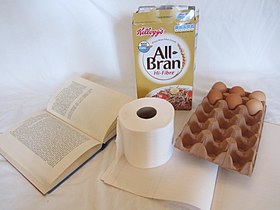
Back Papier Afrikaans Papier ALS ወረቀት Amharic Papel AN Paper ANG ورق Arabic ورق ARZ কাগজ Assamese Papel AST Masinahikanickwemokw ATJ
| Paper | |
|---|---|
 | |
| Material type | Thin material |
| Physical properties | |
| Density (ρ) | From 10 gsm to 3000 gsm |
| Paper | |||||||||||||||||||||||||
|---|---|---|---|---|---|---|---|---|---|---|---|---|---|---|---|---|---|---|---|---|---|---|---|---|---|
 "Paper" in Traditional (top) and Simplified (bottom) Chinese characters | |||||||||||||||||||||||||
| Traditional Chinese | 紙 | ||||||||||||||||||||||||
| Simplified Chinese | 纸 | ||||||||||||||||||||||||
| |||||||||||||||||||||||||
Paper is a thin sheet material produced by mechanically or chemically processing cellulose fibres derived from wood, rags, grasses, herbivore dung, or other vegetable sources in water. Once the water is drained through a fine mesh leaving the fibre evenly distributed on the surface, it can be pressed and dried.
The papermaking process developed in east Asia, probably China, at least as early as 105 CE,[1] by the Han court eunuch Cai Lun, although the earliest archaeological fragments of paper derive from the 2nd century BCE in China.[2]
Although paper was originally made in single sheets by hand, today it is mass-produced on large machines—some making reels 10 metres wide, running at 2,000 metres per minute and up to 600,000 tonnes a year.[not verified in body] It is a versatile material with many uses, including printing, painting, graphics, signage, design, packaging, decorating, writing, and cleaning. It may also be used as filter paper, wallpaper, book endpaper, conservation paper, laminated worktops, toilet tissue, currency, and security paper, or in a number of industrial and construction processes.
- ^ Hogben, Lancelot. "Printing, Paper and Playing Cards". Bennett, Paul A. (ed.) Books and Printing: A Treasury for Typophiles. New York: The World Publishing Company, 1951. pp. 15–31. p. 17. & Mann, George. Print: A Manual for Librarians and Students Describing in Detail the History, Methods, and Applications of Printing and Paper Making. London: Grafton & Co., 1952. p. 77
- ^ Tsien 1985, p. 38